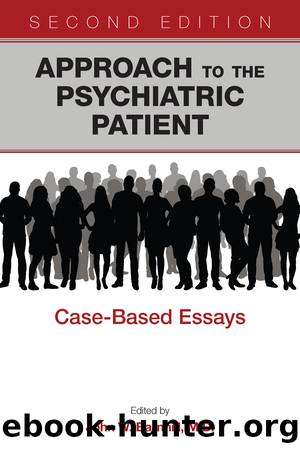Approach to the Psychiatric Patient by Barnhill John W.;

Author:Barnhill, John W.;
Language: eng
Format: epub
Publisher: American Psychiatric Publishing
Published: 2018-08-15T00:00:00+00:00
ADOLESCENT BEREAVEMENT
Cynthia R. Pfeffer, M.D.
Amelia Gutierrez is grieving the death of her mother. This reaction is not simply emotional but also physical, cognitive, and behavioral, and it can lead to crises that are social, religious, and philosophical. To reduce the acute suffering and the likelihood of enduring complications, it is useful to understand such terms as grief, bereavement, depression, and mourning and to explore some of the interventions that can help grieving teenagers.
Whereas grief is a reaction to loss, bereavement is a more enduring state or condition. Both are normal human reactions but can also become abnormal. In the acute setting, uncomplicatedâor normalâbereavement can look like major depression, which includes such symptoms as sadness, diminished interest and pleasure, physical complaints (e.g., problems with sleep, appetite, energy), and a variety of behavioral problems that reflect a personâs developmental age. Although some children and adults will need professional help after the loss of a loved one, most rebound within weeks or months without psychiatric intervention, especially when there is a supportive psychosocial network. These supports stem from family and friends, but because the reaction to death is such a central human experience, cultures and religions have developed behaviors and rituals that help people mourn (feel or show sorrow) such losses.
Amelia faced this major loss, however, without the benefit of her most intimate supportâher motherâor the ongoing support of her old neighbors, community, and church. Her private school may be abandoning her, and her father is suffering from the loss of his wife. Ameliaâs symptoms have become both intense and persistent, and she would now be considered to have complicated bereavement. She is sad and has a constellation of intrusive thoughts and feelings about her mother that interfere with her life. These include anger, guilt, longing for reunion, intrusive memories, and worries about her life without her mother. These reactions are not, however, the primary reasons that she was referred to a psychiatrist. Most notable to her school and father are suicidality and misbehaviors that may be signs of newly developing psychiatric disturbances. This 16-year-old girl has begun to drink alcohol and smoke marijuana, cut her arms, and tell her friends that she wants to die. Such suicidality may reflect an intense desire to rejoin her mother, and although it may not lead to an actual attempt to kill herself, it is worrisome and requires further exploration.
Developmental age influences coping style. Puberty is often accompanied by cognitive and emotional sophistication, for example, and some grieving teenagers respond to loss by becoming âoverachievers.â Puberty also opens up opportunities for problematic behaviors. Turning her back on peers, school, and family, Amelia is experiencing a lonely sadness that appears to be ameliorated only by a connection with an older boyfriend who is introducing her to a world of sex and substance use; although temporarily reassuring, such behavior may lead to school failure, estrangement from friends, and pregnancy. Ameliaâs reaction contrasts with that of her younger brother, whose grief is likely to be expressed as sadness, irritability, and an uncertainty about the meaning of death.
Download
This site does not store any files on its server. We only index and link to content provided by other sites. Please contact the content providers to delete copyright contents if any and email us, we'll remove relevant links or contents immediately.
Human Diseases (MindTap Course List) (by Team-IRA) by Marianne Neighbors Ruth Tannehill-Jones(794)
The Neglected Dimension of Global Security: A Framework to Counter Infectious Disease Crises by National Academy of Medicine Secretariat(405)
Statistical Methods in Health Disparity Research by J. Sunil Rao(388)
Imaging in Urology by Mitchell Tublin MD Joel B Nelson MD(377)
Short Course in Medical Terminology by Nath Judi L.;(321)
Wilkins' Clinical Practice of the Dental Hygienist by Boyd Linda D.;Mallonee Lisa F.; & Lisa F. Mallonee(289)
Clinical Research in Occupational Therapy, Sixth Edition by Martin Rice;(287)
Murray's Basic Medical Microbiology E-Book by Murray Patrick R.;(271)
Anatomical Kinesiology by Gross Michael;(269)
Psychedelics As Psychiatric Medications by Nutt David;Castle David;(260)
Neuroscience Fundamentals for Rehabilitation by Lundy-Ekman Laurie(258)
Public Health and Society: Current Issues by Burke Lillian D.;Weill Barbara;(239)
Health Behavior: Theory, Research, and Practice by Karen Glanz & Barbara K. Rimer & K. Viswanath(239)
The Handbook of Medicinal Chemistry by Simon E Ward;Andrew Davis;(235)
Rang & Dale's Pharmacology 9th Edition plus Flashcards 2nd Edition by Unknown(228)
Cancer Cell Culture by Unknown(226)
Primary Care Occupational Therapy by Unknown(224)
Brown's Evidence-Based Nursing: the Research-Practice Connection by Nowak Emily W.;Colsch Renee; & Renee Colsch(222)
The Politics of Reproduction in Ottoman Society, 1838â1900 by Gülhan Balsoy(220)
